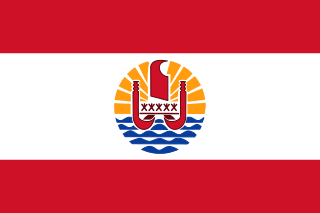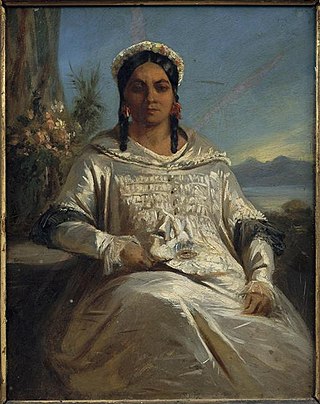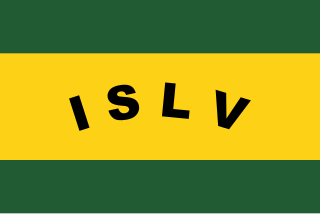Related Research Articles

French Polynesia is an overseas collectivity of France and its sole overseas country. It comprises 121 geographically dispersed islands and atolls stretching over more than 2,000 kilometres (1,200 mi) in the South Pacific Ocean. The total land area of French Polynesia is 3,521 square kilometres (1,359 sq mi), with a population of 278,786 of which at least 205,000 live in the Society Islands and the remaining population lives in the rest of the archipelago.

Tahiti is the largest island of the Windward group of the Society Islands in French Polynesia. It is located in the central part of the Pacific Ocean and the nearest major landmass is Australia. Divided into two parts, Tahiti Nui and Tahiti Iti, the island was formed from volcanic activity; it is high and mountainous with surrounding coral reefs. Its population was 189,517 in 2017, making it by far the most populous island in French Polynesia and accounting for 68.7% of its total population; the 2022 Census recorded a population of 191,779.

Pōmare IV, more properly ʻAimata Pōmare IV Vahine-o-Punuateraʻitua, was the Queen of Tahiti between 1827 and 1877. She was the fourth monarch of the Kingdom of Tahiti.

Raiatea or Ra'iatea is the second largest of the Society Islands, after Tahiti, in French Polynesia, in the South Pacific Ocean. The island is widely regarded as the "centre" of the eastern islands in ancient Polynesia and it is likely that the organised migrations to the Hawaiian Islands, New Zealand and other parts of East Polynesia started at Raiatea.

Taha’a is an island located among the western group, the Leeward Islands, of the Society Islands in French Polynesia, an overseas territory of France in the South Pacific Ocean. The islands of Taha’a and neighboring Raiatea to the immediate south are enclosed by the same coral reef, and they may once have been a single island. At the 2017 census it had a population of 5,234. The island has an area of 90 square kilometres. Mount Ohiri is the highest mountain on the island standing at 590 metres (1,940 ft) above sea level. It is also known as the "Vanilla Island" and produces pearls of exceptional quality.

The Leeward Islands are the western part of the Society Islands in French Polynesia, an overseas collectivity of France, in the South Pacific Ocean. They lie south of the Line Islands, east of the Cooks and north of the Austral Islands. Their area is 404 km2 and their population is over 36,000.

The Society Islands are an archipelago in the South Pacific Ocean that includes the major islands of Tahiti, Moʻorea, Raiatea, Bora Bora and Huahine. Politically, they are part of French Polynesia, an overseas country of the French Republic. Geographically, they form part of Polynesia.

This page list topics related to French Polynesia.

The Kingdom of Tahiti or the Tahitian Kingdom was a Polynesian monarchy founded by paramount chief Pōmare I, who, with the aid of British missionaries and traders, and European weaponry, unified the islands of Tahiti, Moʻorea, Teti‘aroa, and Mehetiʻa. The kingdom eventually annexed the Tuamotus, and the Austral Islands.
The Pōmare dynasty was the reigning family of the Kingdom of Tahiti between the unification of the islands by Pōmare I in 1788 and Pōmare V's cession of the kingdom to France in 1880. Their influence once spanned most of the Society Islands, the Austral Islands and the Tuamotu Archipelago.

The Kingdom of Bora Bora was established during the early 19th century with the unification of the island of Bora Bora and official recognition by France and the United Kingdom in 1847 through the Jarnac Convention. It was one of a number of independent Polynesian states in the Society Islands, alongside Tahiti, Huahine and Raiatea in the 19th century, which all shared a similar language and culture and whose rulers were interrelated by marriage. Besides Bora Bora, the Kingdom encompassed the islands of Tupai, Maupiti, Maupihaa, Motu One, and Manuae. The Kingdom was finally annexed to France in 1888 and its last queen Teriimaevarua III was replaced by a French vice-resident in 1895.
Rere-ao Te-hau-roa-ari'i, also given as Teri'i-hau-roa, was the Queen of Raiatea and Tahaa. In the Tahitian language, her name means "flying-in-the-world" and "perpetual peace" or "long governments of kings".

Teriitaria II or Teri'itari'a II, later known as Pōmare Vahine and Ari'ipaea Vahine, baptized Taaroamaiturai, became Queen of Tahiti when she married King Pōmare II and later, she ruled as Queen of Huahine and Maiao in the Society Islands.

Teri'i-maeva-rua II was the Queen of Bora Bora from 1860 until her death in 1873.

Tamatoa IV, also named Moe'ore Teri'itinorua Teari'inohora'i (1797–1857) was the king of Raiatea and Tahaa from 1831 to 1857.

Victoria Pōmare-vahine was a Tahitian princess and daughter of Queen Pōmare IV of Tahiti and her husband Ariʻifaʻaite a Hiro. A member of Pōmare Dynasty, she was born during the outbreak of the Franco-Tahitian War (1844–1847) when the Tahitian royal family were exiled to the neighboring island kingdom of Raiatea. She was named after the British Queen Victoria in hopes of a British intercession in the conflict.

The Franco-Tahitian War or French–Tahitian War (1844–1847) was a conflict between the Kingdom of France and the Kingdom of Tahiti and its allies in the South Pacific archipelago of the Society Islands in modern-day French Polynesia.

The annexation of the Leeward Islands or the Leewards War was a series of diplomatic and armed conflicts between the French Third Republic and the native kingdoms of Raiatea-Tahaa, Huahine and Bora Bora, which resulted in the conquest of the Leeward Islands, in the South Pacific archipelago of the Society Islands in modern-day French Polynesia.

Teraupo'o was a Tahitian (Maohi) resistance leader of the islands of Raiatea and Tahaa who fought off French rule from 1887 to 1897 during the decade-long Leeward Islands War.

Tuarii or Tūari'i was the queen regnant of Raiatea and Tahaa in the Leeward Islands of the Society Islands, part of present-day French Polynesia. She was the last monarch of the kingdom of Raiatea-Tahaa from 1887/1888 to 1897 before the conquest and annexation of the islands to France.
References
- ↑ de la Roncière, Bertrand (2003). La reine Pomaré: Tahiti et l’Occident 1812-1877. Éditions L’Harmattan. p. 232.
- ↑ Toullelan, Pierre-Yves. Encyclopédie de la Polynésie. Vol. 6, La Polynésie s'ouvre au monde 1769-1842. p. 65.
- ↑ Deschanel, Paul (1884). La politique française en Océanie. À propos du Canal de Panama. p. 527. Archived from the original on 2016-11-23. Retrieved 2019-11-07.
- ↑ "Le fait colonial en Polynésie orientale 1880-1939". des.pf. Archived from the original on 8 October 2014. Retrieved 4 November 2006.
- 1 2 Cheung, Francis (1998). Tahiti et ses îles (1919-1945) : étude d'une société coloniale aux antipodes de sa métropole. L'harmattan. p. 44.
- ↑ "Hapaitahaa a Etau, dit Teraupoo, le rebelle". ladepeche.pf. 24 January 2010. Archived from the original on 5 July 2013.
